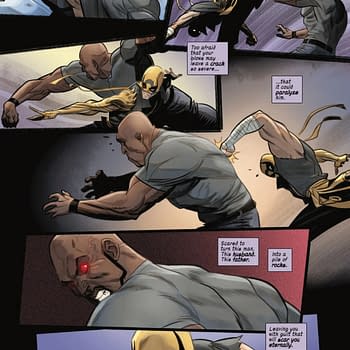Posted in: Comics | Tagged: Alan Moore, alec baldwin, Batman, bill finger, bob kane, Comics, entertainment, harry houdini, Orson Wells, the shadow, Walter B Gibson
Who Knows What Evil Lurks In The Heart Of The Shadow? Part I

He is said to have inspired many of the heroes we know today including the title character from Alan Moore's V For Vendetta and his closest facsimile Batman. Bill Finger said that he used The Shadow and other pulp characters for inspiration when creating Batman with Bob Kane and even used one of the Shadow pulp novels, Partners In Peril by Theodore Tinsley as the basis for Batman's first adventure. In the early Batman comics we see the character written in more of a pulp style, using guns and not shying away from killing people. Much more like the Shadow than the Batman we know of today.

The Shadow started off as part of an idea to increase sales of publisher Street and Smith's Detective Story Magazine. A radio program was commissioned to enact some of the stories from the magazine and a deep voiced narrator was added to tie the show together. A few name choices were bounced around including The Inspector, The Sleuth, before they settled on The Shadow. The idea worked in part as listeners began asking for The Shadow Magazine instead of Detective Story.

The Shadow Gibson created was named Kent Allard, a celebrated fighter pilot who served in World War I, often known as the Black Eagle (or later Dark Eagle). Allard crashes into the jungle of South America where he discovers a great amount of wealth. He decides to fake his death and at some point decides to take on a life of crime fighting. He then returns to New York and takes up various aliases. The most famous of course being Lamont Cranston. But in the pulps, Cranston is a separate person, not just a name. In their first meeting Allard insinuates to Cranston that he had replaced a few key signatures and could easily just take Cranston's wealth, but instead he makes a deal that allows Allard to pose as Cranston while the real Lamont is traveling the world. Not sure how blackmailing someone is the first step into becoming a crime fighter.

It may have also been out of convenience that the radio program changed made its biggest change. Gone was Kent Allard, now the Shadow was Lamont Cranston. Maybe the whole concept of the fake death, taking the aliases and the real Cranston traveling the world would be too much to explain to the listeners… or maybe they just didn't want their hero to start off by committing multiple crimes.
To Be Continued…
The Shadow can currently be seen in the Dynamite Entertainment comic series The Shadow: Midnight In Moscow written and drawn by comic legend Howard Chaykin.














